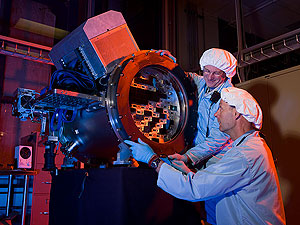
FACT SHEET: Click here to download PDF.
NAME: The Dark Energy Survey, or DES, which uses the Dark Energy Camera, called DECam
WHAT WILL THIS TELL US? Because gravity causes mass to attract other mass, over time, this gravitational pull should slow the universe’s expansion. Instead, the universe is accelerating: Galaxies are speeding away from each other faster and faster. DES aims to help pin down the cause of this acceleration. Theorists offer two possibilities: Either three-quarters of the universe is dark energy, which causes a type of anti-gravity, or gravity itself behaves differently on cosmic scales than Einstein thought it did. The answer will determine the fate of the universe. If Einstein was correct, the expansion of the universe will continue to speed up, and in 100 billion years the observable universe will be almost empty of galaxies or will have ripped apart.
To find clues to the characteristics of dark energy, DES will trace the history of the expanding universe roughly three-quarters of the way back to the time of the Big Bang. It will do this by measuring the distribution of galaxies throughout space, how the gravity of dark matter distorts their shapes, how galaxies cluster and the brightness of exploding stars called supernovae.
WHY IS THIS EXPERIMENT NEEDED NOW? Research during the last decade using different methods has confirmed that the expansion rate of the universe is speeding up. The next step is to understand why the expansion rate of the universe is accelerating—its physical cause. The answer is likely to change our understanding of the behavior of the natural forces, such as gravity, that cause everything in the world to interact.
WHAT IS DES LOOKING FOR? DES will survey about one-tenth of the sky, or 5,000 square degrees, to measure 300 million galaxies and carry out repeat surveys over a smaller portion of the sky to discover thousands of supernovae.
FUNDED BY: DOE, NSF, non-U.S. funding agencies and participating institutions
NUMBER OF COLLABORATORS: More than 120 scientists, plus students and postdocs
U.S. COLLABORATING INSTITUTIONS: Four national labs, eight universities, one national observatory
NON-US COLLABORATING INSTITUTIONS: 13 universities and research centers (Germany, Brazil, UK, Spain)
STATUS: Final construction and testing of DECam is underway; part shipments to Chile set for September 2010 through June 2011.
LIFESPAN OF EXPERIMENT: Starting in 2012 and continuing for five years
PHYSICS FRONTIER EXPLORING: Cosmic Frontier
HOW DOES THIS FIT INTO FERMILAB’S STRATEGIC PLAN? The U.S. particle physics community has made it a priority to study dark energy. DES is Fermilab’s major near-term experiment in this area.
FUN FACTS:
- DECam’s photo-sensitive chips, called CCDs, are more sensitive than a conventional digital camera, particularly for red and near-infrared wavelengths, so they can record more light for a given exposure time.
- A single DES camera image captures an area 20 times the size of the moon as seen from Earth.
- The DES will record information on more than 300 million galaxies, most so faint that their light is about 10 million times fainter than the dimmest star that can be seen with the naked eye.
- Some of these galaxies are so distant that the light we see from them left the galaxy when the universe was only a third of its current age, about 9 billion years ago.
- The collaboration’s signature drink is Pisco-Sour, a traditional Chilean drink made from distilled grapes found in the valleys near the Blanco telescope.
HOW DOES IT WORK? Light from a distant galaxy travels for billions of years across the universe and reflects off the 4-meter-wide mirror of the Blanco telescope at the Cerro Tololo Inter-American Observatory in Chile. This light gets focused by a series of five lenses onto a large digital camera, DECam. Each lens has a unique shape, with the biggest being almost 1 meter in diameter. The 570-megapixel camera contains 62 digital chips called charge-coupled devices, or CCDs, that each contains 8 million pixels, plus 12 chips of 4 million pixels each for guiding and focusing. When light from a distant galaxy enters the camera and strikes an atom in a pixel, it produces electrons that get converted to a digital signal that a computer can store to create a snapshot.
Because the light from distant galaxies shows up in different colors (wavelengths) depending on their distances from Earth, DECam takes pictures through five different filters (from blue to red) and uses the resulting galaxy colors to determine their distances.
WHAT EXPERIMENTS DOES IT BUILD ON? DES builds on the Sloan Digital Sky Survey. DECam builds on the silicon vertex detectors of CDF and DZero.
WHAT MAKES THE EXPERIMENT UNIQUE?
- DECam will have the largest optical survey power in the world and will carry out the largest galaxy survey.
- For the first time, a single experiment will carry out all four techniques for probing dark energy: surveys of supernovae, galaxy clusters, large-scale structure and weak gravitational lensing.
LEARN MORE:
- Dark Energy Survey website: https://www.darkenergysurvey.org